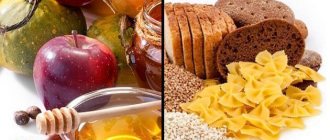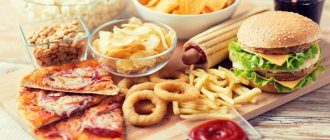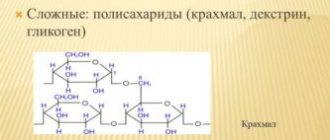Daily protein intake
Each person needs an individual amount of protein daily. It depends on gender, weight and other factors. It is important not to overdo it and not eat only protein-rich foods. In any case, nutrition should be balanced and rational. Eating too much protein will not lead to increased muscle growth, although some people believe it will. Even 300 grams of pure protein per day will not cause the body to produce muscle tissue faster than possible.
Research says that for athletes and people who are trying to gain weight, the protein norm is equal to 1.5-2.5 g per 1 kg of weight. That is, with a weight of 70 kg, a man needs about 200 g of protein, a woman with a weight of 60 kg needs 165 g per 1 kg of weight. For weight maintenance or weight loss, this value is reduced by 10% or 20% respectively. But do not forget that this is purely individual, and you should rely on your feelings, observing changes in your figure and well-being. It is impossible to understand from the first day whether the diet has been chosen correctly; at least a month must pass, after which you can adjust your diet.
What are fast proteins
So, let's start with fast proteins. This type of protein has an increased degree of digestibility and digestibility. When they enter the human body, their processing occurs in just a few hours, and the very fact of being in the internal environment of the body does not cause the slightest discomfort.
Who needs fast proteins in the first place? Fast proteins are ideal for athletes and those people who regularly experience heavy physical activity. In addition, fast proteins are indispensable for people who are often exposed to stress, as they quickly replenish the number of calories burned as a result of an increase in the level of the stress hormone cortisone in the blood.
Why I love my robot vacuum cleaner so much: sharing my own experience
According to nutritionists, fast proteins should be consumed shortly before the start of a workout, as well as 30-60 minutes after the end of a sports activity. This will help the athlete’s body quickly return to normal after exercise. It is recommended to take fast proteins in small portions. The indicator of their assimilation is equal to one or as close as possible to this value.
List of Protein Rich Foods
Not all foods have the same nutritional value and calorie content, and, accordingly, the amount of protein. Animal products (meat, fish, poultry), legumes, cereals and other products are richest in it. Proper protein nutrition for muscle growth is built on protein-rich foods; there are recipes for dishes (for example, boiled chicken fillet with lentils) that are considered “impact” dinners for athletes. With one such meal, you can reach the normal amount of protein consumed. Eating such food is best in the evening, since fats are too heavy for the digestive system and digestion during sleep, and carbohydrates provide energy that is absolutely not needed at night; consuming carbohydrates at night will only lead to the gain of fatty tissue, not muscle tissue. Let's find out which foods contain protein
10 foods with the highest protein content
There are foods that contain practically no protein, such as sweets and desserts; such dishes are not eaten on a protein diet, but there are record-breaking foods for protein content. It is on the basis of this food that proper protein nutrition is built.
List of foods rich in protein:
- Soy – up to 35 g;
- Boiled veal – up to 31 g;
- Peanuts – 26 g;
- Chicken breast – 25 g;
- Tuna – 23 g;
- Beans and peas – 22 g;
- Cheese – 19 g;
- Shrimp – 18 g;
- Cottage cheese – up to 17.5 g;
- Chicken egg – up to 14 g.
From this list it is clear that not only animal products are rich in protein, but also plant-based ones. This means that vegetarians, vegans, and other people who follow certain diets for moral reasons or health reasons can keep their body in good shape and build muscle, despite the fact that there is a popular myth about the lack or absence of protein in plant foods.
Such a variety of products allows you to combine them with each other and create more and more new dishes that will help diversify the menu even on a protein diet.
Which ones are called slow
Slow proteins are proteins that, in contrast to fast proteins, are absorbed by the human body for quite a long time. The average processing time for slow proteins varies from five to eight hours.
Why are slow proteins needed? Slow-acting proteins are very useful for people who have set themselves the goal of losing weight. They perfectly and for a long time satisfy the feeling of hunger, restore muscles, enrich them with amino acids and protect muscles from destruction while following strict diets for weight loss. Slow proteins work best in this direction if consumed before bed. Overnight they manage to be digested without problems and absorbed by the body 100%. In addition, this approach saves a person from the possibility of an unbridled desire to enjoy something tasty and high-calorie in the middle of the night. The rate of absorption of slow proteins does not reach 1, and significantly.
If you listen to the point of view of doctors, it turns out that the most beneficial for the human body are fast and slow proteins of animal origin. They contain the most complete set of amino acids - both essential and essential - which is why they are called complete proteins.
Protein compatibility
However, without the goal of building muscle, you should not combine high-protein foods very often. To process proteins from different sources, gastric juice of different acidity and different enzymes are needed. A constant combination of proteins + proteins will lead to some problems with the gastrointestinal tract, for example, the process of breaking down starch may be disrupted.
A combination of proteins and carbohydrates is not the best option, since the digestion of carbohydrates occurs in an alkaline environment, and proteins in an acidic environment with a high pH. Mixing these two substances leads to fermentation of foods, heartburn, heaviness and general malaise.
It is best to combine proteins with vegetables that contain little starch, as this also inhibits the digestion of food. These are vegetables like
- Cabbage;
- Radish;
- Bell pepper;
- Celery;
- Zucchini;
- Tomatoes;
- Spinach and other salads.
Thus, if necessary, you can occasionally correct the lack of protein with a combination of two or more high-protein foods, but in ordinary life it is better to replace such a combination with protein + fiber, that is, non-starchy vegetables.
Meat protein table
Different types of meat have different amounts of protein. In particular, meat protein is distinguished by its high content of amino acids, which practically do not decompose during heat treatment.
| Protein content in meat products | |||
| Veal | Up to 31 g | Pork lean | 25 g |
| Goose | 29 g | Mutton | 21-24 g |
| Chicken (no skin) | 25 g | Rabbit / hare | 24 g |
| Turkey | 24 g | Chicken stomachs | 20-22 g |
| Smoked sausage | ≈20g | Duck stomachs | 19.5 g |
| Beef | 19-23 g | Lamb liver | 19 g |
| Chicken liver | 18-21 g | Beef liver | 17 g |
| Chicken heart | 15-22 g | Beef tongue | 16 g |
| Pork liver | 18 g | Lamb heart | 15 g |
| Duck | 17.5 g | Lamb kidneys | 14 g |
| Beef/pork heart | 15 g | Beef kidneys | 12.5 g |
| Pork kidneys | 14 g | Boiled sausage | 10-12 g |
Fish and seafood proteins
| Protein content in fish, fish and seafood | |||
| Chum salmon caviar | 27 g | Beluga / Cod liver | 24 g |
| Sardine | 23.7 g | Tuna | 23 g |
| Mullet | 21.4 g | Pike-perch / Pink salmon / Bream | 21 g |
| Carp | 19.9 g | Sea bass / Shrimp / Saberfish | 20 g |
| Whitefish | 19 g | Saira | 18.6 g |
| Crabs | 18.7 g | Horse mackerel | 18.5 g |
| Ide | 18.2 g | Pike / Mackerel / Salaka | 18 g |
| Squid | 18 g | Shrimps | 17.8 |
| Flounder | 16.1 g | capelin | 13.4 |
| Cod | 17.5 g | Herring | 17.3 |
| Blue whiting | 17.9 g | Pollock / Sterlet / Catfish | 17 |
| Icy | 17.4 g | Sturgeon | 16.5 |
| Salmon | 20.8 g | Hake | 16.6 |
| Trout | 15.5 g | Oysters | 14 |
| Lamprey | 15 g | Canned fish in tomato | 12.8-19.7 g |
| Canned fish in oil | 17.4-20.7 g | Canned fish in its own juice | 20.9-28.7 g |
Milk proteins
| Protein content in dairy products | |||
| Milk | 2.8 g | Yogurt | 5 g |
| Kefir | 2.8 – 3.0 g | Buttermilk | 2.5 – 2.7 g |
| Sour cream | 3.0 – 3.4 g | Cottage cheese 20% | 14 g |
| Ryazhenka | 3.5 g | Smoked sausage cheese | 23 g |
| Curdled milk | 2.2 g – 2.8 g | Powdered milk | 25.6 g |
| Hard cheese | 25-35 g | Skim cheese | 16 g |
| Processed cheese | 20 g | Cream | 3.0 – 3.2 g |
| Ice cream | 3.5 g | Condensed milk | 8 g |
| Ayran (tan) | 2 g | Cheese Brynza | 17.9 g |
| Adyghe cheese | 18.5 g | Goat cheese | 22 g |
| Cheese Tofu | 8.1 g | Sulguni cheese | 20 g |
| Baked milk | 2.9 g | Goat milk | 3.6 g |
| Kumis | 2.1 g | Matsoni | 2.8 g |
| Butter | 0.9 g | Goat curd | 16.7 g |
Cereals
Detailed table with protein content in products
| Protein content in cereals, porridges, cereals and legumes | |||
| Bulgur | 12.3 g | Chickpeas | 20.1 g |
| Peas | 21.5 g | Oat groats | 11.9 g |
| Buckwheat | 13.5 g | Cereals | 11.7 g |
| Buckwheat flakes | 9.0 g | Pearl barley | 9.3 g |
| Quinoa | 14.1 g | Spelled | 14.7 g |
| Porridge 7 grains | 12.0 g | Sprouted wheat | 7.5 g |
| Corn grits | 8.3 g | Wheat groats | 11.5 g |
| Cornflakes | 7.4 g | Soft wheat grains | 11.8 g |
| Dry couscous | 12.8 g | Durum wheat grains | 13.0 g |
| Flaxseed porridge | 32.3 g | Wheat flakes | 11.0 g |
| Semolina | 11.4 g | Millet porridge | 11.2 g |
| Rye flakes | 6.4 g | Millet cereal | 11.5 g |
| Raw white rice | 5.0-8.0 g | Rye (grains) | 9.9 g |
| Brown rice | 7.4 g | Sago | 1.0 g |
| Brown rice | 6.3 g | Grain sorghum | 11.8 g |
| Golden rice | 8.1 g | Wheat talkan | 11.5 g |
| Red rice | 10.5 g | Teff | 13.3 g |
| Polished short grain rice | 0.1 g | Oatmeal | 12.5 g |
| Rice flakes | 7.0 g | Triticale | 12.8 g |
| White beans | 21.0 g | Lentils | 27.3 g |
| Red beans | 23.0 g | Barley grits | 10.4 g |
| Barley groats | 10.0 g | Barley flakes | 9.8 g |
Protein Digestibility Chart
All protein - both animal and plant - has a different effect on the body, is perceived differently by it, and therefore is absorbed differently. It depends on the amino acid composition. More precisely, from the ratio of one type of amino acid to another. The body does not synthesize the necessary amino acids, but uses only what it comes with food. If one of the amino acids is missing for the assimilation of proteins, then the rest will not be used. Easily digestible protein includes animal protein; an exemplary example of digestibility is the chicken egg - its digestibility is close to 100%. It is difficult to obtain protein from plant foods due to the lack of diversity in the composition of amino acids; protein in cereals and fruits is absorbed worst of all, since there are not enough components for this.
| Digestibility of protein in various foods | |||
| Product Names | Amount of protein | Absorption rate squirrel (PDCAAS) | Protein absorption percentage |
| Egg | 12.7 g | 1.0 | 100% |
| Egg powder | 45.0 g | 1.0 | 100% |
| Serum | 2.9 g | 1.0 | 100% |
| Milk, kefir | 2.8 g | 1.0 | 100% |
| Cottage cheese | 16.7 g | 1.0 | 100% |
| Cheese | 25.0 g | 1.0 | 100% |
| Beef | 18.9 g | 0.92 | 92% |
| Pork (not fatty) | 16.4 g | 0.63 | 63% |
| Pink salmon | 21.0 g | 0.90 | 90% |
| Chicken (poultry) | 20.8 g | 0.92 | 92% |
| Wheat | 12.7 g | 0.54 | 54% |
| Oats | 11.9 g | 0.57 | 57% |
| Rice | 7.0 g | 0.55 | 55% |
| Buckwheat | 12.6 g | 0.66 | 66% |
| Beans | 22.3 g | 0.68 | 68% |
| Peanut | 26.3 g | 0.52 | 52% |
| Peas | 23 g | 0.67 | 67% |
| Soybeans | 34.9 g | 0.91 | 91% |
| Corn | 8.3 g | 0.60 | 60% |
| Rye | 10.7 g | 0.63 | 63% |
| Cottage cheese | 15.0 g | 0.84 | 84% |
| Beans | 21 g | 0.49 | 49% |
| White bread | 9.0 g | 0.97 | 97% |
| Whole wheat bread | 11.3 g | 0.92 | 92% |
| Lentils | 27.3 g | 0.84 | 84% |
| Red caviar | 31.6 g | 0.90 | 90% |
| Squid | 21.2 g | 0.90 | 90% |
| Mutton | 22.0 g | 0.90 | 90% |
| Salmon | 21.7 g | 0.90 | 90% |
| Rabbit meat | 24.0 g | 0.90 | 90% |
| Tuna | 23.0 g | 0.90 | 90% |
Types and features
There is an opinion that the type and characteristics of the protein are not particularly important. But that's not true. Depending on the type of protein, its effectiveness and speed of action on the body may vary.
Thus, all proteins (by origin) are classified into two types:
- animals. The main sources are animal products such as beef, milk, chicken, fish and so on. Their advantages are the best rate of absorption by the body and high quality. But you can't overdo it here. Excessive consumption of animal proteins can lead to a number of side effects. For example, overindulgence in egg whites can cause rashes or other skin manifestations;
- vegetable. Here, from the name, it is clear that the source of proteins is plants. The richest sources include walnuts, almonds, hazelnuts, millet, oatmeal, and so on. The disadvantage of plant proteins is low quality of digestibility, small volume, low efficiency. As a rule, plant proteins bring the greatest benefit when combined with their animal counterparts.
In addition, all proteins can be divided according to the speed of absorption. There are two types here:
- fast. The peculiarity of such elements is their high rate of absorption by the body. This protein is broken down into amino acids and reaches the cells within 60-80 minutes after ingestion. Fast proteins promote recovery, gain muscle mass, and increase strength;
- slow. Their peculiarity is long-term breakdown in the body. The advantage is that the cells are nourished with nutrients for 6-8 hours. Slow proteins are great for solving several problems - muscle growth, weight loss, preventing catabolic processes, and so on. A great option is to take slow protein before going to bed.
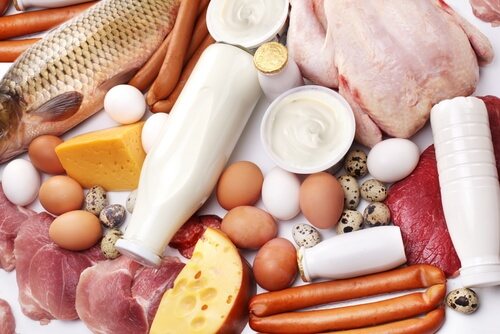
At night, the body calmly copes with protein foods and absorbs the necessary amino acids. Another plus is the effectiveness of slow protein for weight loss. If you eat foods containing such protein, you may not feel hungry for a long time.
Signs of protein deficiency
A lack of protein in the body manifests itself as follows:
- An irresistible desire to eat a certain product
It happens that you have a strong craving for sweet, salty or sour foods and it’s impossible to cope with it. Not always, but in frequent cases it is closely related to a lack of proteins.
- Sharp pain in muscles or joints
If your neck or knee suddenly hurts for no apparent reason and in the absence of diseases, you need to check whether there is enough protein in your diet. The body stores a little protein in reserve, which is closely related to the functioning of muscles and joints. With its constant shortage, this reserve is spent, which means health problems arise.
- Problems with sleep and fatigue
The body replaces the lack of proteins with an additional portion of carbohydrates and sugar, but they are quickly processed, energy is thrown away, and after a while it is not enough. If you have insomnia, you can try to reduce the amount of sweets and focus on protein.
- Moodiness, irritability, bad mood and constant stress
After a certain period of a protein-free regime, the body is completely exhausted, and even carbohydrate energy surges cannot save it. This leads to general malaise and irritability.
The nuances of eating fast and slow proteins
“Slow” proteins contain fewer calories, take a long time to digest, and this process requires the body to expend a significant amount of energy. Nutritionists recommend consuming this type of protein before bed; this can be done without harm or any fear.
A late meal (two to three hours before going to bed) with food with slow proteins will fill you up and will not harm your health or figure. Overnight, the body will do an excellent job of digesting it, and the muscles will be able to fully enrich themselves with the amino acids they need so much.
You should also eat slow proteins in situations where you need to be guaranteed to be full for a long time. The feeling of hunger will not bother you for a long time after eating this way.
Fast proteins are very useful for anyone who is intensely involved in sports (both professional and amateur). These same proteins are indispensable for people whose lives are filled with serious physical activity. If, for some reason, you need to quickly get a powerful boost of energy and a surge of strength, food of animal origin with quickly digestible proteins will help you.
Important advice: such food (fish, meat products, cheeses) should not be excessively fatty. Another nuance is that protein products that have undergone moderate temperature treatment and crushed are absorbed faster and with maximum benefit. It is for this reason that all protein shakes are prepared primarily using a blender.
Protein content of available foods

In order to eat right and healthy, you don’t have to spend a lot of money on it. What inexpensive foods contain protein? List of available high protein foods:
- Buckwheat;
- Chicken;
- Peanut;
- Peas and beans;
- Chicken eggs;
- Hard, processed or any other cheese;
- Cottage cheese;
- Lentils;
- Canned fish and any other products.
In any case, one nutritious meal high in protein and fiber will not cost more than a fast food snack, which will give the body nothing but empty calories and unhealthy fat.
Review of popular protein diets
Protein diets are very popular and quite effective, since the main sources of food for this form of weight loss are dishes high in protein. Diets of this kind have many advantages and disadvantages.
Advantages:
- Protein is the best component for restoring energy if you combine diet with exercise;
- protein diets are designed for no more than 7 days, and this is a fairly quick achievement of results in a short period of time;
- Protein foods satiate the body for a long time, which means that this diet is not one of the “hungry” diets.
Minuses:
- with unlimited protein consumption, the human body removes fluid and calcium reserves;
- Also, playing sports provokes an increased load on the kidneys, which will affect the appearance: the skin dries, the hair loses its color saturation, the nails peel off;
- when on a protein diet, you need to alternate product categories to avoid allergies;
- You should carefully monitor the amount of fat.
The list of foods that you can eat on a protein diet is in the table:
| Product | Protein content per 100g | Fat content per 100 g | Product | Protein content per 100 g | Fat content per 100 g | ||
| Chicken breast | 22 | 1 | Turkey | 22 | 12 | ||
| Beef cutlet | 20 | 8 | Beef | 19 | 12 | ||
| Beef liver | 17 | 3 | Pink salmon | 21 | 7 | ||
| Lamb liver | 19 | 3 | Oatmeal | 12 | 6 | ||
| Chickens | 21 | 9 | Rice | 7 | 1 | ||
| Chick | 19 | 8 | Beans | 22 | 2 | ||
| Tuna | 23 | 1 | Soy milk | 52 | 1 | ||
Ducan's diet
This diet is the most popular weight loss system in the world. The author identifies 4 stages:
- The attack is a major weight loss that lasts about five days.
- Alternation is a continuation of weight loss, lasting up to several months.
- Consolidation - establishing the results at the same level; the duration of the stage can be found by multiplying each kilogram of weight lost by ten.
- Stabilization – maintaining results throughout life.
Each stage of the Dukan Diet requires a unique list of foods.
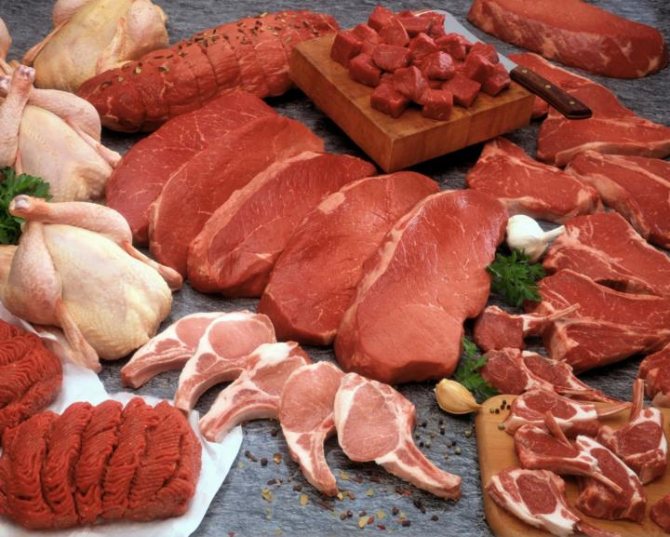
Atkins diet
The Atkins diet was the first low-carbohydrate diet. Reducing carbohydrates means that on this diet you mainly eat protein foods, the list of which is very wide.
Basic Rules:
- Reduce carbohydrate intake.
- Eat according to your appetite.
- Take multivitamins.
- Practice physical activity.
- Drink enough water.
This diet shapes eating habits, and the results appear over time, but are permanent if you follow the recommendations.
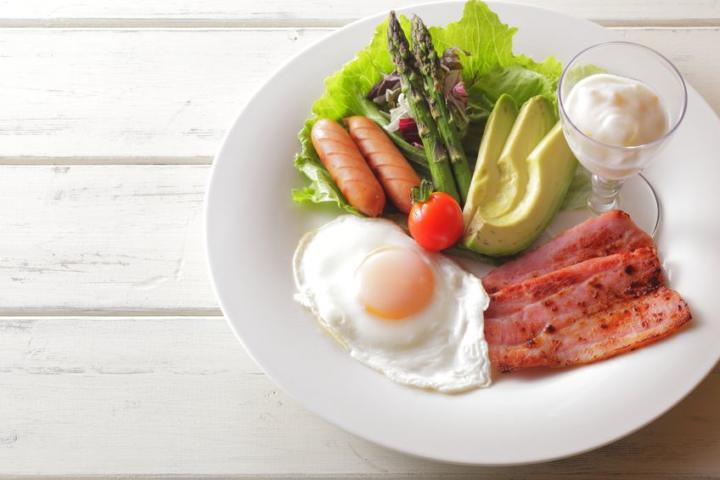
Diet Hayley Pomeroy
Hayley Pomeroy's weight loss system has five basic principles:
- No stress and a positive attitude.
- Don't cut out foods that bring you pleasure from your diet.
- Abandon strict dietary rules.
- Don't count calories.
- Try to build a diet so as not to feel hungry.
The Monday and Tuesday diet on this diet consists of cereals, fruits, vegetables and protein. From Wednesday to Friday - protein and vegetables. Saturday, Sunday – protein, vegetables, fruits, healthy fats.

List of the healthiest protein foods
The most important thing in food is not only the protein content, but also the overall ratio of dietary fat, vitamins and nutrients. You cannot rely only on one positive point of a product; nutrition must be complete and varied.
Example of the most useful products:
- Cottage cheese – high calcium content
- Peanuts - healthy vegetable fats
- Tuna or any other fish - fish oil and omega
- Oatmeal or other porridge are slow carbohydrates that fill you up for a long time and provide a large supply of energy.
- Soy - a huge supply of vitamins B1, B2, B3, B5, B6, B9, C and omega-3 and omega-6 fatty acids
Red meat
Red meat typically comes from large animals. It contains higher levels of myoglobin, resulting in a red color. Red meat is associated with heart disease and diseases such as diabetes, cardiovascular disease and obesity. Red meat is also linked to colorectal cancer. This is because red meat contains more saturated and trans fats than white meat. Because red meat has more fat, it also has more calories. There are reduced fat and additional lean options. However, red meat contains more iron, zinc and vitamin B compared to white meat. The iron found in red meat is called heme iron, which is easily absorbed by the body.
The importance of protein for the body
View this post on Instagram
The bamboo shoots that pandas eat contain 2.6 grams of protein for every 100 grams. We bet you that pandas would grow even bigger if they knew which foods contained a lot of protein. Find out what to include in your diet to safely call it “high-protein” (naturally, on our website
